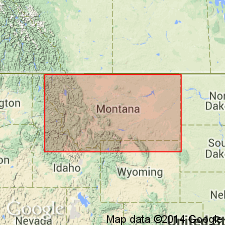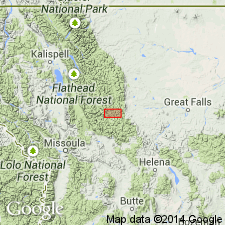
- Usage in publication:
-
- Camp Creek series*
- Modifications:
-
- Original reference
- Dominant lithology:
-
- Sandstone
- Shale
- AAPG geologic province:
-
- Northern Rocky Mountain region
Summary:
Pg. 2-7, 9, 18. Camp Creek series [Camp Creek group]. Present in Mission Range, central western Montana. Thickness 11,700 feet. Younger than Blackfoot series (new) and older than Cambrian Flathead sandstone. Age is pre-Cambrian (Belt series). Report includes correlation chart.
Named from exposures on Camp Creek, Mission Range, Lake and Missoula Cos., central western MT.
[Misprint (USGS Bull. 896, p. 326): entry under Camp Creek belongs under Camp Springs.]
Source: US geologic names lexicon (USGS Bull. 896, p. 326); supplemental information from GNU records (USGS DDS-6; Denver GNULEX).

- Usage in publication:
-
- Camp Creek series†
- Modifications:
-
- Abandoned
Summary:
Pg. 348. †Camp Creek series of Walcott abandoned. =Missoula Group. Although Camp Creek has priority, it has been little used.
Source: Publication.
For more information, please contact Nancy Stamm, Geologic Names Committee Secretary.
Asterisk (*) indicates published by U.S. Geological Survey authors.
"No current usage" (†) implies that a name has been abandoned or has fallen into disuse. Former usage and, if known, replacement name given in parentheses ( ).
Slash (/) indicates name conflicts with nomenclatural guidelines (CSN, 1933; ACSN, 1961, 1970; NACSN, 1983, 2005, 2021). May be explained within brackets ([ ]).

